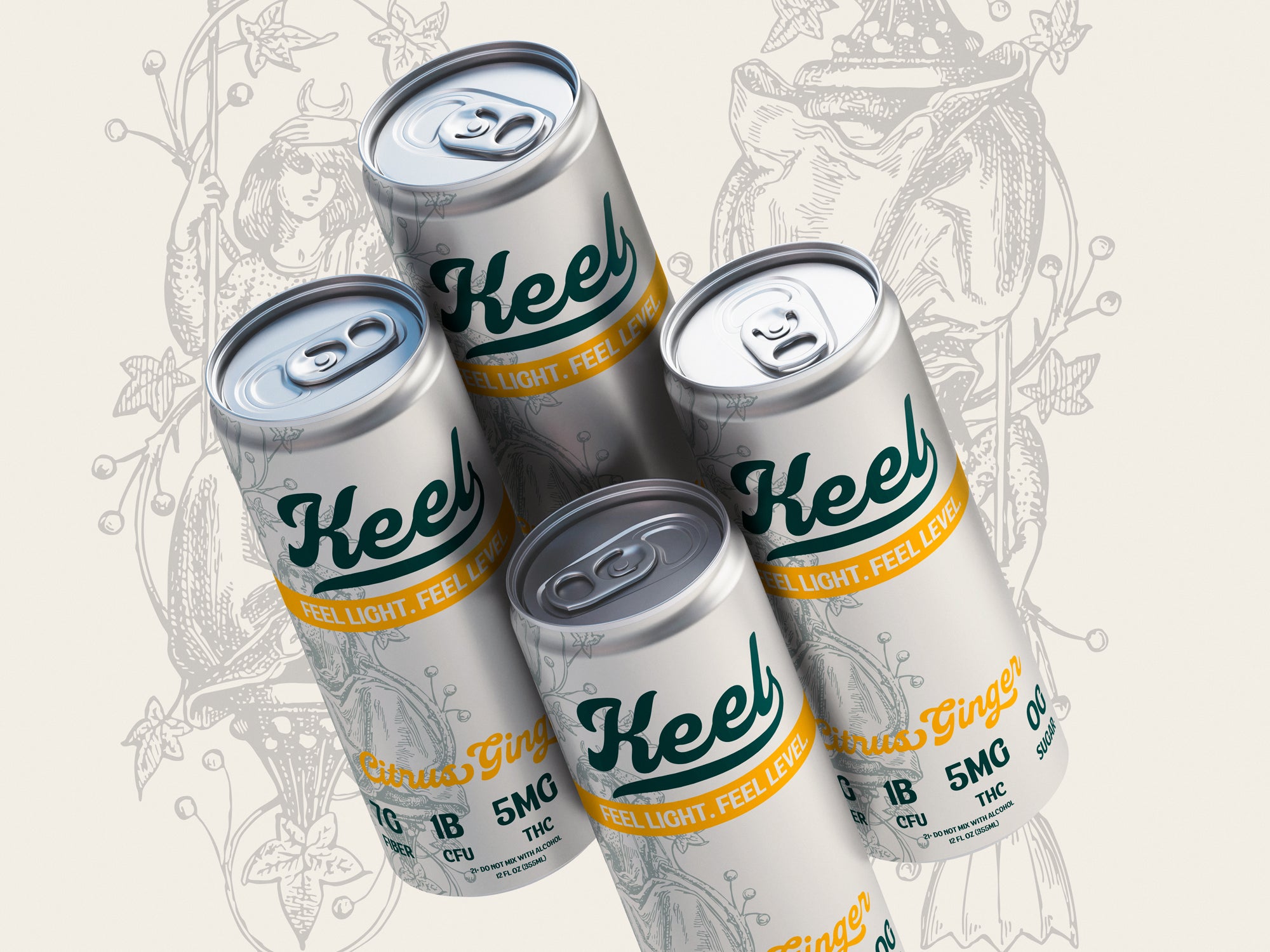TL;DR
Synbiotics = prebiotics + probiotics together. Look for 5–7g fiber + 1B CFU at shelf life + under 5g added sugar. Drink daily for gut health. Synbiotics outperform prebiotics-only sodas because they add live bacteria, not just fiber.
A synbiotic drink combines prebiotic fiber with live probiotic bacteria in one beverage, designed so the fiber feeds the probiotics and helps them survive your digestive tract. Prebiotics are non-digestible fibers (like PHGG or resistant maltodextrin) that gut bacteria ferment into beneficial compounds, while probiotics are live microorganisms (measured in CFU, or colony-forming units) that colonize your gut. Together, they support regularity, reduce bloating, and improve nutrient absorption more effectively than either ingredient alone. Look for drinks with at least 5 grams of fiber, 1 billion CFU verified at shelf life, and minimal added sugar.
What "Synbiotic" Means
Synbiotic is a term for products that pair prebiotics and probiotics in a single formulation. The prefix "syn-" means together; the combination is intentional. Prebiotic fibers act as fuel for probiotic bacteria, improving their survival through stomach acid and helping them thrive once they reach your intestines. This pairing became popular in gut health research around 2020, as studies showed that probiotics paired with their preferred fiber sources outperformed probiotics taken alone.
Not every drink with fiber and probiotics qualifies as a true synbiotic. The fiber type must actually support the specific probiotic strain. For example, Bacillus coagulans pairs well with resistant maltodextrin, while Lactobacillus strains prefer inulin or FOS (fructooligosaccharides). Reputable brands test and verify this compatibility before labeling a product synbiotic.
Why Combine Prebiotic Fiber with Probiotics
Prebiotics and probiotics serve different roles in your gut, and combining them creates a synergistic effect. Prebiotic fibers pass through your upper digestive tract undigested, reaching your colon where beneficial bacteria ferment them into short-chain fatty acids (SCFAs) like butyrate and propionate. These SCFAs lower gut pH, support the intestinal lining, and reduce inflammation.
Probiotics, on the other hand, are live bacteria that temporarily colonize your gut and crowd out harmful microbes. According to a 2025 Mayo Clinic review, probiotics help maintain the gut barrier, support immune function, and aid nutrient absorption. When you drink a synbiotic, the prebiotic fiber gives the probiotic bacteria an immediate food source, increasing their activity and longevity in your system. Research published in Gut Microbes (2024) found that synbiotic formulations improved Bifidobacteria and Lactobacilli counts more than probiotics alone after four weeks of daily use.
Synbiotics are particularly useful if you have low dietary fiber intake (the average American consumes 16 grams daily versus the recommended 25–38 grams). A synbiotic drink with 7 grams of fiber and 1 billion CFU can fill gaps in both categories, especially for people who avoid fermented foods or struggle with vegetable-heavy diets.
CFU and Survivability 101
CFU stands for colony-forming units, a measure of viable bacteria in a probiotic product. A count of 1 billion CFU means 1 billion live bacteria cells capable of reproducing. Higher CFU counts (10 billion, 50 billion) are common in supplements, but drinks typically contain 1–5 billion CFU because liquid formats are harder to stabilize.
Survivability matters more than CFU count at manufacture. Stomach acid kills most probiotics within 30 minutes of ingestion. Spore-forming strains like Bacillus coagulans and Bacillus subtilis survive better because they form protective endospores that withstand acid and heat. Non-spore strains (Lactobacillus, Bifidobacterium) are more fragile and require refrigeration or microencapsulation to reach your intestines alive.
Reputable brands verify CFU at end-of-shelf-life, not just at production. A drink labeled "1 billion CFU" might contain 3 billion at bottling to account for die-off over six to twelve months. Look for labels that specify "guaranteed at expiration" or "verified at shelf life." Drinks stored at room temperature lose viability faster than refrigerated options, though some spore strains remain stable at room temp for 18 months.
Prebiotics enhance survivability by creating a buffer. When probiotics consume fiber during digestion, they produce metabolites that lower gut pH, making the environment more hospitable for subsequent bacteria. This is why synbiotics often outperform standalone probiotics in clinical trials.
How to Evaluate a Synbiotic Drink
Three factors determine whether a synbiotic drink is worth drinking: fiber content, CFU count at shelf life, and added sugar. Use this checklist when comparing options.
| Factor | What to Look For | Why It Matters | Red Flags |
|---|---|---|---|
| Fiber grams | 5–9 grams per serving | Feeds gut bacteria; supports regularity. 7+ grams covers 25–30% of daily needs. | Under 3 grams (too little impact); over 15 grams per serving (may cause bloating) |
| CFU at shelf life | 1 billion+ guaranteed at expiration | Ensures live bacteria reach your gut. Spore strains survive better at room temp. | No expiration guarantee; vague phrasing like "contains probiotics" without CFU number |
| Added sugar | 0–5 grams per serving | Excess sugar feeds harmful bacteria and spikes blood glucose. Natural sugars from fruit are fine. | More than 8 grams added sugar; high-fructose corn syrup; artificial sweeteners if you're sensitive |
| Fiber type | PHGG, resistant maltodextrin, inulin, chicory root | Specific fibers support specific probiotic strains. Check compatibility with strain listed. | Generic "dietary fiber" without source; added thickeners (guar gum, xanthan) marketed as fiber |
| Storage | Check label: refrigerate after opening or shelf-stable with spore strains | Non-spore probiotics die quickly at room temp. Spore strains (Bacillus) tolerate heat better. | Refrigerated product left at room temp for weeks; no storage instructions on label |
A strong synbiotic drink combines 5+ grams of fiber with at least 1 billion CFU of a named strain (not just "probiotic blend"), contains minimal added sugar, and lists a clear expiration or best-by date. Drinks with 7 grams of fiber and 1 billion CFU Bacillus coagulans verified at shelf life hit the sweet spot for daily gut support without excessive calories or bloating risk.
When to Drink a Synbiotic
Timing depends on your goals. For digestive regularity, drink a synbiotic in the morning on an empty stomach. The prebiotic fiber stimulates a bowel movement within 6–12 hours, and the probiotics colonize your gut before food dilutes them. Pair with water to help fiber move through your system.
If you're using a synbiotic as an alcohol alternative in the evening, the fiber and probiotics slow alcohol absorption (if you do drink) and support next-day gut recovery. Many people drink synbiotics during social events as a functional mocktail. A still, non-carbonated synbiotic is easier on your stomach than fizzy prebiotic sodas, which can cause gas when combined with alcohol or heavy meals.
Consistency matters more than timing. Probiotics need daily intake to maintain gut colonization; missing a few days resets your progress. If you experience bloating when starting a synbiotic, reduce to half a serving for the first week. Your gut microbiome adapts to higher fiber within 10–14 days, and symptoms typically resolve. Drink plenty of water (8+ ounces per serving) to prevent constipation from the added fiber.
Frequently Asked Questions
Are synbiotics better than probiotics alone?
Yes, for most people. Synbiotics improve probiotic survival and activity by providing an immediate food source (the prebiotic fiber). A 2024 meta-analysis in Nutrients found that synbiotic supplementation increased beneficial Bifidobacteria and Lactobacilli more than probiotics alone. However, if you already eat 25+ grams of fiber daily from whole foods, a standalone probiotic may be sufficient. Synbiotics are most helpful for people with low fiber intake, irregular digestion, or those recovering from antibiotics.
How much fiber is "high" in a synbiotic drink?
A drink with 7–9 grams of fiber per serving is considered high. This covers roughly 25–35% of the daily recommended intake (25 grams for women, 38 grams for men, per USDA 2020 guidelines). Drinks with 5–6 grams are moderate; under 3 grams is low-impact. Some prebiotic sodas contain 9 grams per can, but splitting that into two servings prevents bloating. If you're new to fiber, start with 5 grams per day and increase gradually over two weeks. Too much fiber too fast (15+ grams per serving) causes gas, cramping, and loose stools.
Do synbiotics need refrigeration?
It depends on the probiotic strain. Spore-forming strains like Bacillus coagulans and Bacillus subtilis are shelf-stable at room temperature for 12–18 months because they form protective endospores. Non-spore strains (Lactobacillus, Bifidobacterium) require refrigeration to stay alive. Check the label: if it says "refrigerate after opening" or "keep refrigerated," the probiotics are fragile. If it says "store at room temperature" or lists a Bacillus strain, it's shelf-stable. Refrigeration extends shelf life for any probiotic but is only required for non-spore strains.
Can I drink a synbiotic every day?
Yes. Daily use maintains probiotic colonization and keeps fiber intake consistent. Your gut adapts to the routine within two weeks. Some people drink synbiotics twice daily (morning and evening), but one serving per day is enough for most goals. If you drink more than one per day, ensure your total fiber stays under 50 grams daily to avoid digestive discomfort. Pair with hydration and whole foods for best results.
Will synbiotics cause bloating?
Possibly, in the first week. When you increase fiber intake, gut bacteria ferment it into gas (hydrogen, methane, CO₂). This is normal and temporary. Bloating peaks around day 3–5 and resolves by day 10–14 as your microbiome adjusts. To minimize bloating, start with half a serving, drink water, and avoid combining with carbonated beverages or heavy meals. If bloating persists past two weeks, try a different fiber type (e.g., switch from inulin to resistant maltodextrin) or reduce CFU count. People with IBS or SIBO may need to avoid high-FODMAP fibers like inulin.
What's the difference between a synbiotic and a prebiotic soda?
Prebiotic sodas contain fiber but no live probiotics. Synbiotic drinks contain both. Prebiotic sodas (like Olipop, Poppi) rely on your existing gut bacteria to ferment the fiber, while synbiotics introduce new bacteria along with their food source. Synbiotics are more effective if your gut microbiome is depleted (e.g., after antibiotics, illness, or poor diet). Prebiotic sodas work well if you already have diverse gut flora and just need a fiber boost. Synbiotics are also typically still (non-carbonated), making them easier to digest than fizzy prebiotic sodas.
Updated On
October 22, 2025
What Changed
- Added 2025 Mayo Clinic review on probiotic efficacy and SCFA production
- Updated CFU survivability section with 2024 Gut Microbes synbiotic study data
- Clarified spore-strain shelf stability (Bacillus coagulans, Bacillus subtilis) vs. non-spore strains
- Expanded fiber evaluation table with red flags and storage guidance
Related Articles
- What is Prebiotic Fiber? – Learn how prebiotic fiber feeds gut bacteria and supports digestive health
- Probiotic Drinks Explained – Understand CFU counts, strains, and how to choose a probiotic drink
- Shop Keel Synbiotic Drink – 7g fiber + 1B CFU Bacillus coagulans, zero added sugar
Sources
- Mayo Clinic Press (2025). Probiotic drinks: What really works for gut health, from kefir to probiotic sodas. https://mcpress.mayoclinic.org/healthygut/probiotic-drinks-what-really-works-for-gut-health-from-kefir-to-probiotic-sodas/
- Omni-Biotic Life (2025). Fiber and Probiotics: Better Together? https://omnibioticlife.com/blogs/blog/can-you-take-fiber-and-probiotics-together
- Tiny Health (2025). Prebiotic and Probiotic Sodas: A Gut-Health Breakthrough or Trend? https://www.tinyhealth.com/blog/prebiotic-and-probiotic-sodas-a-gut-health-breakthrough-or-trend
- USDA (2020). Dietary Guidelines for Americans 2020-2025. Daily fiber recommendations by age and sex.


